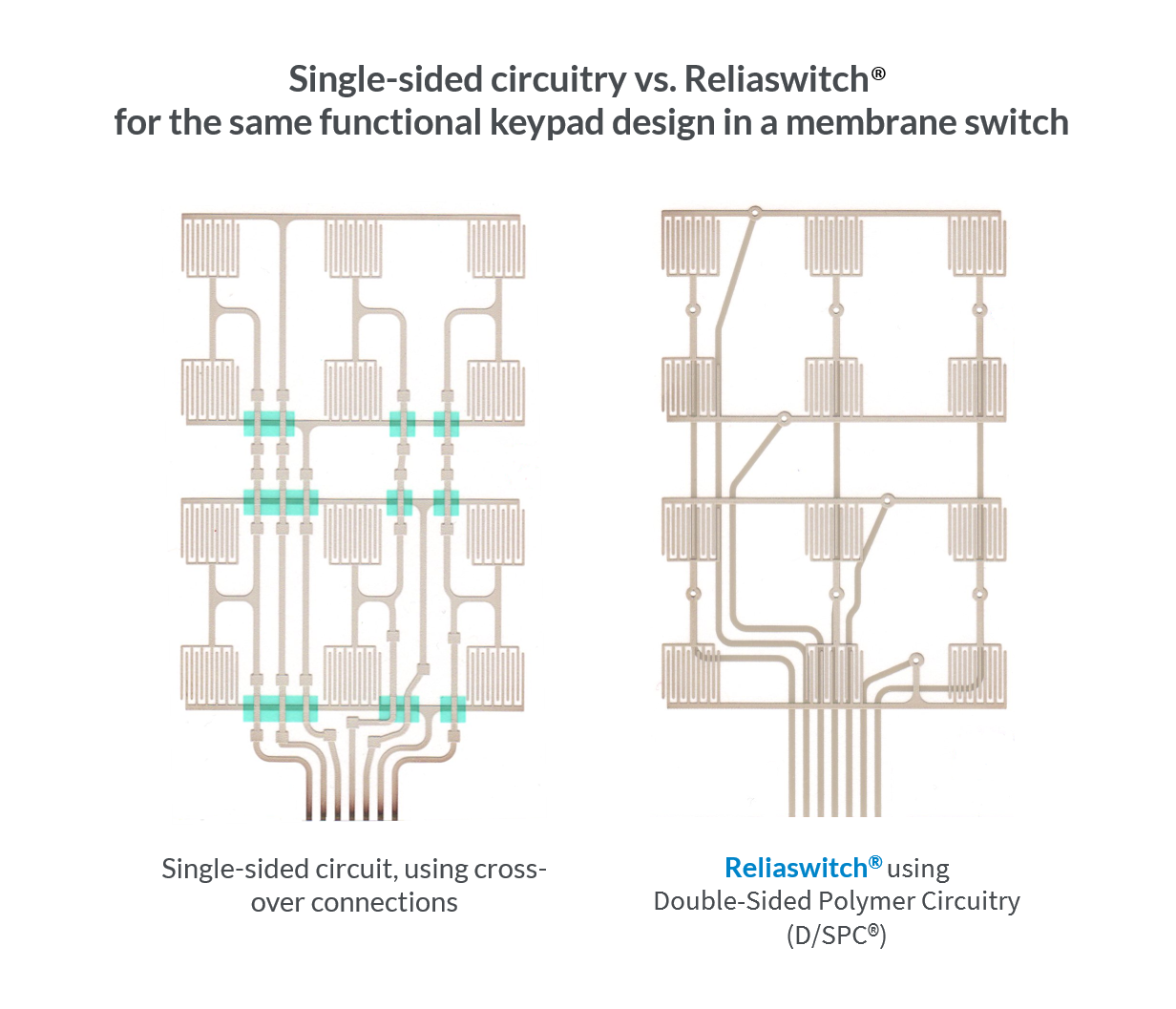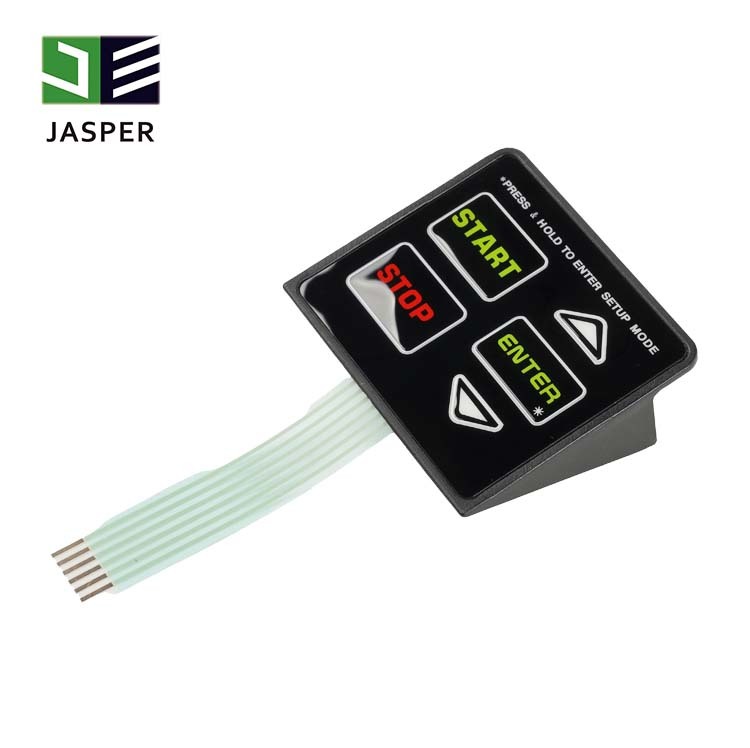Everything About Membrane layer Change: A Comprehensive Overview for Beginners
Membrane buttons are essential elements in modern electronic devices, providing an unique user interface for user communication - membrane switch. Their layered building and construction, including overlays and conductive traces, gives performance and resilience. Unlike typical mechanical switches, membrane layer buttons provide a streamlined design and personalized options. Recognizing their key functions and benefits can transform item design. The details of their application and style considerations require more exploration.
What Is a Membrane Switch over?
A membrane layer switch is a sort of electric button that includes a versatile membrane layer layered over a published circuit board. This style permits a streamlined and compact user interface, usually utilized in different digital tools. Membrane layer buttons are commonly found in consumer home appliances, medical devices, and commercial equipment as a result of their resilience and resistance to environmental factors.The building commonly includes multiple layers, such as graphic overlays and adhesive backing, which offer tactile feedback and safeguard the circuitry underneath. The operation of a membrane switch is initiated when stress is put on the surface area, finishing an electric circuit.These buttons are valued for their adaptability, allowing custom-made styles and printed graphics that cater to specific user interfaces. Their low-profile nature reduces space needs, making them excellent for applications where typical buttons might not fit. In general, membrane buttons use a aesthetic and useful solution for modern-day digital gadgets.
Trick Components of Membrane Layer Switches Over
Membrane switches comprise several key parts that add to their functionality and performance. The top layer, recognized as the overlay, gives the interface and is typically printed with symbols or graphics. Under the overlay exists a spacer layer, which divides the conductive elements and protects against unintended activation. The next crucial element is the visuals layer, which enhances aesthetics and assures the longevity of the design.Conductive traces, normally made from materials like silver or carbon, are printed on the circuit layer. When stress is used to the overlay, these traces enter call, completing the circuit. In addition, a support layer offers architectural support and can be made from products such as polyester or polycarbonate. With each other, these components develop a reputable, user-friendly user interface appropriate for numerous applications, from home devices to industrial tools. Recognizing these elements is important for anyone thinking about membrane switch modern technology.
How Membrane Layer Changes Job
Understanding exactly how membrane layer switches feature is important for appreciating their prevalent usage in different devices. A membrane button runs via a collection of layers, including a graphic overlay, spacer, and a circuit layer. When stress is related to the overlay, it presses the spacer layer, enabling the circuit layer to make get in touch with and complete an electrical circuit. This action sends out a signal to the device, triggering a feedback, such as turning on a light or triggering a function.Membrane switches over can be developed with different attributes, consisting of responsive feedback, backlighting, and personalized graphics, boosting customer interaction. Their building and construction allows for a sealed layout, safeguarding the interior parts from dirt, dampness, and contaminants. This toughness makes them suitable for diverse applications, from consumer electronics to industrial tools. On the whole, the simplicity and effectiveness of membrane layer switches over add to their popularity in modern technology.
Benefits of Membrane Layer Changes Over Mechanical Buttons
While mechanical buttons have long been a staple in numerous devices, membrane switches deal distinctive benefits that make them significantly appealing. One significant benefit is their slim account, enabling even more small layouts and better versatility in product development. Furthermore, membrane layer switches over attribute a consistent surface, which enhances visual charm and simplifies cleansing, making them appropriate for environments where health is critical.Another advantage is their resistance to dust and dampness. Unlike mechanical switches, which can be compromised by ecological elements, membrane layer buttons offer a covered user interface that protects versus pollutants - membrane switch. Moreover, membrane layer switches generally have a longer life-span because of fewer moving components, causing improved sturdiness and reliability.Cost-effectiveness is also a remarkable benefit, as membrane layer switches can be generated wholesale with reduced manufacturing prices. These aspects combine to position membrane layer buttons as a useful choice to traditional mechanical choices in numerous applications
Common Applications of Membrane Switches Over
Membrane layer switches are extensively used in different fields, particularly in customer electronics and industrial control panels. In consumer tools, they supply a sleek, easy to use interface, while in industrial settings, they improve durability and performance. Recognizing these applications highlights the versatility and practicality of membrane switches in contemporary innovation.
Customer Electronic Devices Instruments
As customer electronic devices proceed to evolve, membrane switches have actually become a popular choice for a range of gadgets because of their adaptability and smooth style. These buttons are frequently located in smart devices, tablet computers, and remotes, where room is minimal and appearances issue. Their reduced account and adjustable styles enable makers to develop straightforward user interfaces that boost the total customer experience. In addition, membrane switches are typically utilized in appliances such as microwaves and coffee makers, providing intuitive control alternatives while standing up to wetness and dirt. The resilience and reliability of membrane switches over make them ideal for daily consumer products, guaranteeing long life and regular performance. Overall, their assimilation in consumer electronics reflects a blend of performance and modern-day layout.
Industrial Control Panels
The applications of membrane layer switches over expand beyond customer electronics, finding substantial use in commercial control panels. These buttons are preferred for their sturdiness and resistance to severe settings, making them optimal for manufacturing and procedure control settings. They supply a reputable user interface for operators to control machinery, display processes, and readjust settings. Membrane buttons can be personalized to match particular Continue functional needs, integrating features like backlighting and tactile responses, enhancing individual experience. Their low-profile style enables combination right into various devices, while their capacity to endure spills, dirt, and severe temperatures assurances long life. Overall, membrane buttons add to efficient and risk-free operation in industrial applications, showing their convenience and effectiveness in demanding settings.
Factors To Consider for Designing Membrane Changes
When making membrane switches, choosing the appropriate materials is essential to assure resilience and performance. In addition, comprehending layer arrangement techniques can considerably influence the button's efficiency and customer experience. These factors to consider play an important role in creating dependable and efficient membrane switch designs.
Material Selection Importance
Product option plays an essential role in the layout and performance of membrane switches. The picked products directly affect the switch's durability, responsive feedback, and total visual. Secret considerations include the substratum, which need to supply structural integrity while permitting adaptability, and the visuals overlay, which needs to be resistant to put on and ecological aspects. Conductive materials should guarantee reliable electric performance, while adhesives should offer solid bonding without endangering the switch's operation. In addition, compatibility with making processes and end-user environments is crucial; products need to stand up to varying temperature levels, humidity degrees, and chemical exposure. Eventually, appropriate product choice not only enhances the membrane layer switch's efficiency but also adds to its durability and customer contentment, making it a critical element of the design procedure.

Layer Arrangement Methods

Regularly Asked Concerns
For How Long Do Membrane Layer Switches Over Generally Last?
Membrane layer buttons typically have a life expectancy of 1 to 5 million cycles, depending on usage and environmental problems. Aspects such as style top quality and operating regularity considerably affect their longevity and total performance durability.

Can Membrane Layer Changes Be Custom-made for Particular Designs?
Membrane buttons can certainly be personalized to fit particular designs, allowing for varied shapes, colors, and capabilities. This adaptability allows producers to customize these buttons to meet unique visual and operational needs successfully.
What Materials Are Made Use Of in Membrane Switch Building And Construction?
Membrane layer buttons are normally constructed utilizing materials such as polyester, polycarbonate, and sticky layers. These products offer adaptability, resistance, and resilience to environmental aspects, making certain the switches work successfully in various applications and conditions.
Are Membrane Changes Water-proof or Resistant to Wetness?
Membrane layer buttons can be designed to be moisture-resistant, utilizing specialized products and coatings. However, their water resistant capacities rely on building recommended you read top quality and particular applications, making it important to examine demands for ideal performance in various atmospheres.
Just How Are Membrane Layer Switches Fixed if Harmed?
Repairing damaged membrane switches typically involves changing the influenced layer or circuit. Professionals may also apply news conductive glue or make use of specialized repair service sets, ensuring functionality is recovered without full substitute of the entire button assembly. Unlike traditional mechanical buttons, membrane layer buttons provide a smooth style and customizable alternatives. A membrane layer switch is a kind of electric switch that consists of an adaptable membrane layered over a printed circuit board. The procedure of a membrane layer switch is launched when stress is applied to the surface area, completing an electric circuit.These buttons are valued for their flexibility, enabling personalized styles and printed graphics that cater to details individual interfaces. While mechanical switches have actually long been a staple in numerous tools, membrane switches over offer distinctive benefits that make them increasingly appealing. Membrane layer buttons normally have a longer life expectancy due to less moving components, resulting in enhanced toughness and reliability.Cost-effectiveness is likewise a remarkable benefit, as membrane layer switches can be created in bulk with lower manufacturing prices.